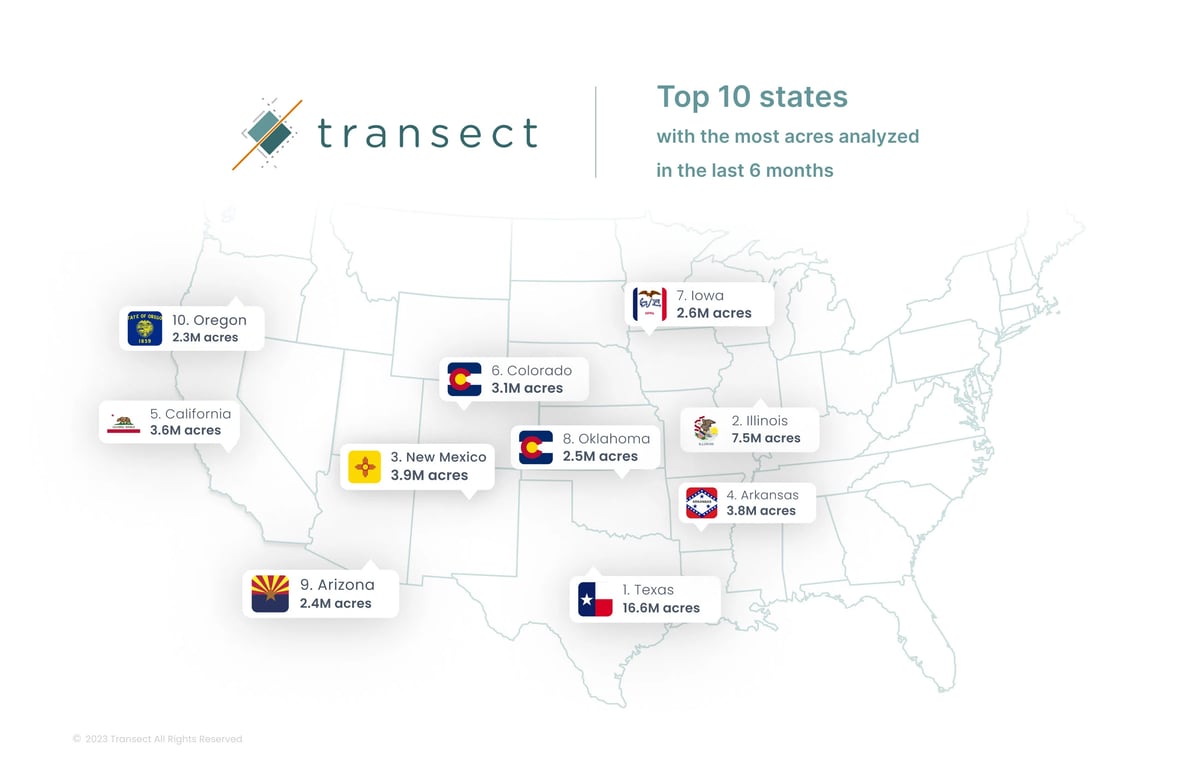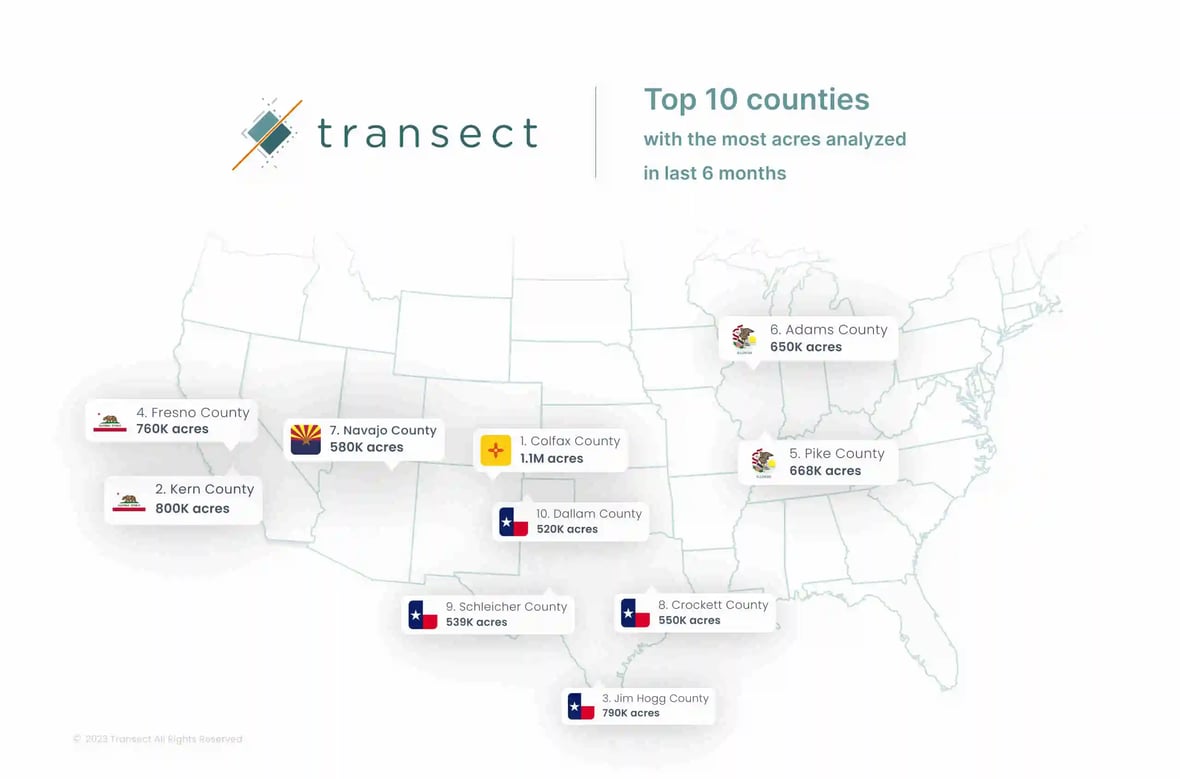
Listen to the audio version
Renewable energy site analysis is on the rise as the clean energy industry continues to expand to meet our critical climate goals, but this growth is not without challenges. Permits, environmental risks, and community sentiment are just some of the hurdles facing renewable energy development. Environmental permitting and associated risks yield the power to delay a project development, making ideal site selection decisions a priority for a successful project. These hurdles can vary drastically by state, establishing certain counties and states the prime locations to host clean energy projects.
In our latest industry study, Transect has delved deep into the future of green energy surveying renewable energy developers. Join us as we uncover the interesting renewable energy industry trends that define the current landscape of the energy sector and explore the promising locations poised to host a myriad of groundbreaking clean energy projects in the upcoming year.
Largest Renewable Energy Developers In The US By State
.webp?width=1180&height=780&name=Top%20States%20Analyzed%20(1).webp)
Fig. 1: The map shown identifies Texas, Illinois, Colorado, Arkansas, Iowa, New Mexico, Arizona, California, Indiana, and Wyoming as the states with the most acres analyzed for renewables development.
Available acreage, state-level rebates and tax credits, and climate patterns are just a few of the reasons these states are evergreen choices for renewable energy development and potential project assessment. The best states for renewable development are in environments that are conducive to producing extensive gigawatts of energy for Americans, provide financial incentives yielding a lower average cost for energy production, and have homeowners generally welcoming to renewable energy.
As environmental regulations and state-level climate change policies change, developers may begin to deter from their usual locations for project sites.
Top States for Renewable Development Across Six Months

Fig. 2: The study indicated that the Texas, Illinois, New Mexico, Arkansas, California, Colorado, Iowa, Oklahoma, Arizona and Oregon shown saw the most acreage analysis in six months prior to survey completion. We expect to see many future renewable projects to be located in these regions.
A state-level assessment provides us with initial insights. However, renewable developers face noteworthy challenges at the local level as well. When surveyed, 84% of respondents stated they see project delays of 3+ months when Influenced by permits or local/ state regulations!
Of those who responded, over 47% develop in new counties for roughly every project they work on. As climate, regulations, and incentives continue to vary increasingly across counties, a thorough analysis of a site will be crucial to project success in 2024.
Assessing a project site's county-level constraints will save developers weeks in project mitigation efforts.
Largest Renewable Energy Developers In The US By County
.webp?width=2560&height=1692&name=Top%20Counties%20Analyzed%20(1).webp)
Fig. 3: Navajo County, Arizona; Kern County, California; Clark County, Nevada; Oldham County, California; Moffat County, Colorado; Morgan County Colorado; Colfax County, New Mexico; Fresno County, California; Lonoke County, Arkansas; and Jim Hogg County, Texas have seen the most acreage analyzed by respondents over time.
Local-level concerns can yield significant project risks and will vary across counties. Permitting timelines, environmental factors, and available acreage differing at the local level may make one county more desirable for renewable development over another. We will likely see a significant amount renewable projects within the counties shown above with record amounts of average analysis.
Top Counties for Renewable Development Across Six Months

Fig. 4: Colfax County, New Mexico; Kern County, California; Jim Hogg County, Texas; Fresno County, California; Pike County, Illinois; Adams County, Illinois; Navajo County, Arizona; Crockett County, Texas; Schleicher County, Texas; and Dallam County, Texas Counties were identified by respondents as those with the most acres analyzed six months prior to survey completion. Notably, a significant portion of these counties’ all time acreage analysis (seen in Fig. 3) occurred within the six months prior to the survey.
Developers will continue to face new challenges on the road to project completion and find new criteria by which they must assess their site.
When surveyed, the most common concerns during site assessment were:
-
Local sentiment toward clean energy projects
-
Access to transmission lines
-
Protected waterways
We expect these concerns to be at the forefront of barriers to renewable development in 2024, and a key point of site assessment for projects to come.
The energy industry will likely see a rise in acres assessed at both the county and state levels in the coming year. Powered by the support of regulatory efforts and financial incentives, the clean energy industry will continue to expand and thrive. Additionally, automated tools allow developers to assess a project site in seconds, skyrocketing the amount of acreage analysis possible for each unique project.
Want to learn more about rising renewable development trends and project delays facing your site? Read the full report!
